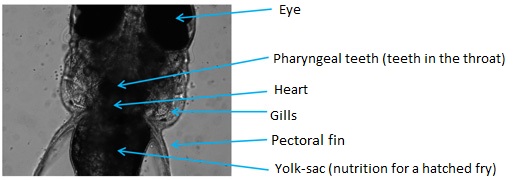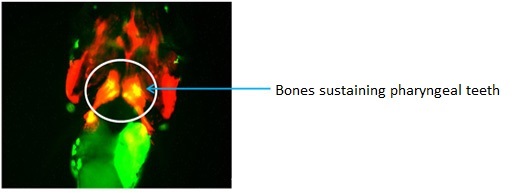This is an archive of information released in the past.
Disclaimer: It may contain broken links or outdated information. Some parts may not function in current web browsers.
*Visit https://humans-in-space.jaxa.jp/en/ for the latest information.

Experiment
- News
- Kibo Utilization Strategy
- Kibo Utilization Plan
- List of JAXA's Utilization Themes
- Experiment Facilities
- Space Environment Utilization
- Archive
Observational experiment of medaka's osteoclast2 was conducted on board Kibo
A life science experiment "Effect of microgravity on osteoclasts and the analysis of the gravity sensing system in medaka* (Medaka osteoclast2)," was conducted using a fluorescence microscope on board Kibo, the Japanese Experiment Module.
*Principal Investigator (PI) Akira Kudo
Professor, Department of Biological Information, Graduate School of Bioscience and Biotechnology, Tokyo Institute of Technology.
Medaka (Oryzias latipes) in the observation chambers were delivered aboard the Progress spacecraft (54P) from the Baikonur Cosmodrome at 1:23 am, February 6, 2014 (Japan Time).
After the arrival at the International Space Station (ISS), Astronaut Koichi Wakata set the observation chamber to the fluorescence microscope, and the observation was conducted from February 7 to February 14.
During a long-term space flight, astronauts' bone mineral density is known to decrease rapidly. The phenomenon is considered due to the disruption of balance between the amount of newly formed bone and the amount of bone absorbed into the blood. Activation of the bone desorption cells (osteoclasts) is assumed to cause the decrease of bone mineral density in space; however, the basic mechanism is still unknown.
By studying the osteoclast cells of medaka fish in microgravity, discovery of a novel mechanism of absorbing bones may be possible. The results are expected to be a start of the development of a new treatment for senile osteoporosis, of which a loss of cortical bone mass is seen.
Following the first experiment (Medaka osteoclast) conducted for two months from October 2012, a short-term fluorescence observation was conducted this time (Medaka osteoclast2). Transgenic juvenile medaka whose osteoclast or osteoblast cells specifically become fluorescent was observed using a fluorescence microscope this time.
【Remarks from the PI, Prof. Kudo】
We are observing the bones of juvenile medaka that has four kinds of transgenic lines. Today is the fifth day of the one-week consecutive observation, and we are excited to see the osteoblasts and osteoclasts of a live medaka. We really appreciate medaka for living up to our expectations.
【Images taken on Kibo】
Photo taken on February 10, 2014, with a 10X objective lens
(Photo courtesy of Prof. Kudo, Tokyo Institute of Technology)
<Bright-field image>

<Fluorescence image>

Metabolically active bones that sustain pharyngeal teeth are worthy of attention. Bones expressed in yellow are osteoclast and osteoblast cells while these expressed in red are osteoblast cells only.
See for another Medaka experiment: Medaka Osteoclast
*All times are Japan Standard Time (JST)
| Copyright 2007 Japan Aerospace Exploration Agency | Site Policy |